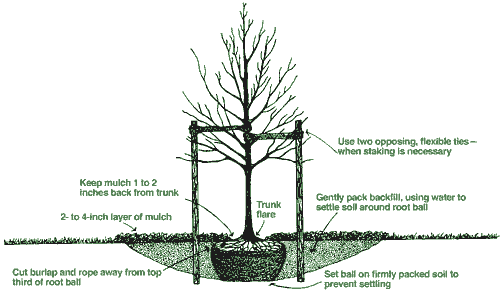Stormwater is water that used to soak into the ground and become ground water prior to development but runs off of impervious surfaces, collecting pollutants until it ultimately enters our surface waters. These pollutants include trash, chemicals, sediment, and oils among many others. Population growth and development rates are increasing the amount of pollutions and the volume and rate of runoff from impervious surfaces. Stormwater runoff pollution causes changes in hydrology and water quality that then result in habitat modifications, increased flooding, decreased aquatic biological diversity, and increased sedimentation and erosion. Best management practices (BMPs) like tree planting filter out pollutants and/or prevent pollution by controlling it at its source.
Trees provide a range of benefits ranging from aesthetic benefits to environmental benefits to recreational benefits and even to economic benefits. Trees may be the easiest stormwater control measure to implement at home, and the benefits of this measure span so many different aspects that it is definitely worth the initial cost.
Stormwater Benefits: Trees capture, store, intercept, and slow rainfall through their roots and canopies. This delays the onset of and reduces the volume of peak flows. By doing so, trees also decrease flooding and erosion by reducing the negative effects of runoff from smaller, more frequent storms.
Air Quality Benefits: Trees help improve air quality by reducing levels of ozone, nitrogen dioxide, dust, smoke, pollen, and other pollutants. In fact, trees absorb between 120-240 pounds of nitrogen dioxide, sulfur dioxide, ozone, and particulate matter to use in biological functions. These compounds have clean-up costs between $2.06-$3.34/lb, so trees are not only cleaning our air but saving us money! Through a process known as evapotranspiration, trees release water used for photosynthesis back into the atmosphere. This helps cool the air and reduce air temperatures by 5-10°F in the summer months. Trees help purify our air while also combating urban heat island effects.
Soil Quality Benefits: Through root growth, trees help create soil conditions that promote infiltration of rainwater into the soil. This helps replenish the groundwater supply and maintain streamflow during dry periods as well. In addition, through a process called phytoremediation, trees absorb trace amounts of harmful chemicals like metals, organic compounds, fuel, and solvents to use as nutrients or store in their roots, stems, and leaves. Trees are able to convert these pollutants into less harmful and actually useful substances.
Energy Consumption Benefits: By reducing air temperatures and breaking wind currents, trees are able to reduce our heating and cooling costs. In fact, trees have been shown to reduce energy consumption costs by 8-12%. This saves both households and businesses money.
Community Benefits: Trees benefit not only the property owners but the community as well through both the environmental benefits and health benefits as well. Providing an opportunity for recreation, trees help reduce stress and increase fitness. The presence of street trees has also been linked with lower crime rates and quicker recovery rates. A study conducted in Pennsylvania showed that hospital patients with a view of trees recovered more quickly and with fewer complaints than those with a view of only a brick wall. Trees are also linked with improved perceptions of business districts and 8-12% more consumer spending in these areas.
Economic Benefits: Trees provide a number of economic benefits like reduced utility bills and increase consumer spending. A study in Indiana calculated the value of the environmental and economic services produced by trees annually: trees conduct $9.7 million in energy conservation services, $24.1 million in stormwater management, $2.8 million in air quality improvement, and $1.1 million in carbon sequestration services every year. Is that worth the cost of buying and maintaining street trees?
For more information on the benefits of tree plantings, contact Tinker’s Creek Watershed Partners.


